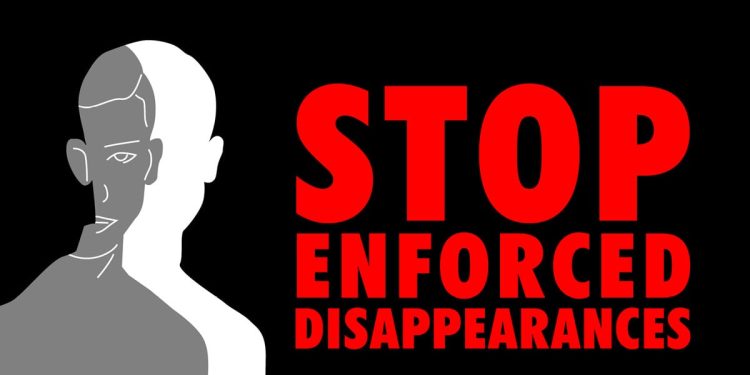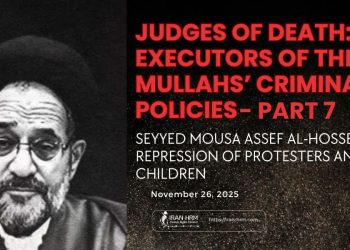Introduction
30 August, International Day of the Victims of Enforced Disappearances commemorates the thousands who were torn from their families through state secrecy and denial. “Enforced disappearance” means arrest, abduction, or any form of deprivation of liberty by state agents or those acting with state authorization, followed by a refusal to acknowledge the deprivation of liberty or by concealment of the fate or whereabouts of the disappeared person.
In Iran, this organized crime has persisted from the 1980s to the present day: from the mass killings of 1988, through the 2022 uprising, to ongoing cases inside prisons.
Methodology & Scope
This report draws on testimonies from families and survivors, documentary records, reporting by Amnesty International and the Iran Human Rights Society, media archives, and open-source research. Wherever possible, each allegation is corroborated by at least two independent sources.
Ethical safeguards were applied: identities are withheld where disclosure could pose risks; informed consent was obtained when feasible; otherwise, only publicly available materials were used.
Key limitations include blocked access to prisons and suspected mass-grave sites, intimidation of families, and destruction or fencing-off of evidence.
Documentation and analysis follow the Minnesota Protocol (2016) on the Investigation of Potentially Unlawful Death.
Legal Framework
| International instrument | Adoption/entry into force | Key provisions | Oversight body | Iran’s status |
| UN Declaration on the Protection of All Persons from Enforced Disappearance | 18 Dec 1992 | Definition of enforced disappearance; absolute prohibition; state responsibility | UN Working Group on Enforced or Involuntary Disappearances (WGEID) | Principles apply to Iran as customary international law |
| International Convention for the Protection of All Persons from Enforced Disappearance (ICPPED) | Open for signature 6 Feb 2007; in force 23 Dec 2010 | Defines enforced disappearance as a crime against humanity; criminalization; jurisdiction | Committee on Enforced Disappearances (CED) | Not a party; core principles bind Iran under customary international law |
Part I — The 1988 Massacre
In summer 1988, thousands of political prisoners were executed extrajudicially and buried in secret mass graves. Families were neither informed of the fate of their loved ones nor allowed to mourn. Khavaran cemetery remains a symbol of this crime, amid ongoing pressure, tampering, and enclosure.
Under the international instruments above, the 1988 mass killings constitute enforced disappearances and crimes against humanity. Even though Iran has not joined the ICPPED, the prohibition is binding under customary international law. Continued concealment and denial violate these obligations.
Part II — The 2022 Uprising
1) Patterns of enforced disappearance
- Arbitrary arrests in streets and homes without notifying families.
- Transfers to undisclosed detention sites (e.g., “Ward 59” and “Ward 66”) and denial of legal safeguards.
- Prolonged solitary confinement with cut-off of calls and visits.
- Short, controlled phone calls used to sustain uncertainty for families (a form of psychological torture).
- Secret burials or delayed handover of bodies to families.
2) Targeted groups
- Youth and minors (e.g., Mehdi Mahmoudi, 17; Saleh Bahramzehi, 16).
- Women opposing compulsory veiling.
- Ethnic and religious minorities, notably Kurds and Baluchis.
- Journalists, academics, human rights defenders.
- Dual/foreign nationals (e.g., Ahmadreza Djalali).
3) Systematic tactics
- Solitary confinement as an instrument of disappearance.
- “Off-the-grid” transfers to remove detainees from judicial oversight.
- Withholding information from families.
- Using disappearance as a precursor to torture and coerced confessions.
4) Consequences
Enforced disappearance functioned as a core tool in a broader strategy of repression during 2022—manufacturing fear, enforcing social norms (like compulsory hijab), and exerting political control over society.
Part III — Ongoing Practices in Prisons
- Bijan Kazemi: Over seven months incommunicado after transfers to security facilities in Qom.
- Arghavan Fallahi: Calls cut off after transfer from Evin to QezelHesar; recently moved to Qarchak with continued incommunicado concerns.
- Five political prisoners sentenced to death – Pouya Ghobadi, Vahid Beni-Amerian, Shahrokh Daneshvarkar, Babak Alipour, and Mohammad Taghavi – were held in solitary confinement in Qezel Hesar Prison for two weeks following their transfer from Fashafouyeh Prison. During this period, they launched a hunger strike in protest and were completely cut off from contact with their families. After this period, they were transferred to the political ward of Qezel Hesar Prison.
- Ali Younesi: Months of disappearance; later confirmed held in Qezel Hesar.
Part IV — International Reactions and the Justice Movement
- UN General Assembly (December 1988): Expressed concern over the wave of executions of political prisoners in summer 1988.
- UN Special Rapporteurs (2 September 2017): Report included the 1988 massacre for the first time in detail.
- Asma Jahangir (25 October 2017): Called for independent investigations, citing letters from families of victims.
- UN Human Rights Council (12 March 2018): Last report of Asma Jahangir presented and discussed.
- UN experts’ letter (9 December 2020): Stated the events may amount to crimes against humanity and emphasized that the crime continues until the fate and whereabouts are clarified.
- Amnesty International & Human Rights Watch: Repeatedly described the 1988 executions and subsequent concealment as crimes against humanity.
- 150 former UN officials and NGOs (3 May 2021): Open letter urged creation of an international commission of inquiry.
- Javaid Rehman (29 June 2021): Urged investigation into Ebrahim Raisi’s role in the 1988 massacre.
- Human Rights Watch (8 June 2022): Labeled the 1988 mass killings as crimes against humanity.
- Sweden—Hamid Nouri case (2022): A landmark universal-jurisdiction trial based on survivor testimony and robust documentary evidence resulted in a life sentence. Although later undercut by appeasement policies, the judgment remains a historic record and precedent.
Human & Social Impact
Enforced disappearance inflicts ongoing psychological torture on families—decades of not knowing, coupled with denial of mourning rites. In 2022, families of disappeared minors were threatened and harassed. Within prisons, the cut-off of calls and visits drives families into psychological and economic collapse.
This policy targets not only individuals but society at large, enforcing fear and breaking collective resistance.
Accountability & Remedies
- Immediate publication of full lists of detainees and their places of detention.
- International protection of suspected mass-grave sites (e.g., Khavaran) to prevent evidence destruction.
- Full cooperation with WGEID, CED, and the UN Fact-Finding Mission on Iran.
- Criminal proceedings against perpetrators under universal jurisdiction where available.
- Truth, reparations, and guarantees of non-recurrence for families.
- End harassment of families and respect the right to mourning and assembly.
Conclusion & Call to Action
Enforced disappearance in Iran is a deliberate, ongoing policy. From Khavaran to the 2022 uprising and today’s prisons, families remain trapped in uncertainty and pain.
We urge the UN Human Rights Council, WGEID, CED, and states committed to justice to:
- launch an independent international investigation;
- protect mass-grave sites;
- prosecute those responsible;
- and secure truth, reparations, and non-recurrence for families.
Until truth is revealed and justice delivered, enforced disappearance is a continuing crime.
Compact Website Table (Chronological)
This list is compiled from credible human rights sources including Amnesty International and UN documentation.
| Name | Date of Disappearance | City / Province | Current Status |
| Collective victims of the 1988 massacre | Summer 1988 | Evin, Gohardasht | Secret burials; families kept in the dark |
| Siamak Barati | Autumn 2022 | Unknown | Enforced disappearance; whereabouts unknown |
| Nader Teimouri | Autumn 2022 | Unknown | Enforced disappearance; whereabouts unknown |
| Ahmadreza Djalali | 2022 | Tehran | Prolonged incommunicado; at risk of execution |
| Fariborz Babakhani | 2022 | Kurdistan | Fate unknown |
| Emad Mazraeh | 2022 | Unknown | Enforced disappearance |
| Mehdi Mahmoudi | 2022 | Aligudarz | Enforced disappearance (minor) |
| Three Kurdish political prisoners | Aug 2022 | Kurdistan | Group enforced disappearance |
| Saleh Bahramzehi | 2022 | Sistan & Baluchestan | Enforced disappearance (minor, Baluchi) |
| Rasam Sohrabi | 2022 | Kurdistan | Enforced disappearance |
| Hamidollah Arbabi | 2023 | Sistan & Baluchestan | Incommunicado |
| Saeed Masoudi | 2023 | Tehran | Incommunicado |
| Iman Khedri | 2023 | Unknown | Incommunicado |
| Hafizollah Shahbakhsh | 2023 | Sistan & Baluchestan | Incommunicado |
| Danial Meshki | 2023 | Tehran | Incommunicado |
| Parisa Darvish | 2023 | Tehran | Incommunicado |
| Ali Younesi | 2024 | Tehran | Temporary enforced disappearance; later confirmed inQezelHesar |
| Bijan Kazemi | Aug 2024 | Tehran | Over seven months incommunicado |
| Arghavan Fallahi | Jun 2025 | Tehran (Evin →QezelHesar → Qarchak) | Recently transferred to Qarchak; incommunicado concerns persist |
| Vahid Bani-Amerian | Aug 2025 | Tehran (Fashafouyeh →QezelHesar) | 2 weeks blackout after transfer |
| Pouya Ghobadi | Aug 2025 | Tehran (Fashafouyeh →QezelHesar) | 2 weeks blackout after transfer |
| Babak Alipour | Aug 2025 | Tehran (Fashafouyeh →QezelHesar) | 2 weeks blackout after transfer |
| Akbar Daneshvarkar | Aug 2025 | Tehran (Fashafouyeh →QezelHesar) | 2 weeks blackout after transfer |
| Seyed Mohammad Taghavi | Aug 2025 | Tehran (Fashafouyeh →QezelHesar) | 2 weeks blackout after transfer |
| Osman Mameh | Jul 2025 | Mahabad, Kurdistan | Total blackout |







